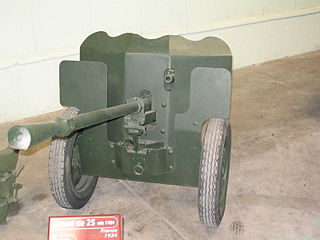
The AMX-13 is a French light tank produced from 1952 to 1987. It served with the French Army, as the Char 13t-75 Modèle 51, and was exported to more than 26 other nations. Named after its initial weight of 13 tonnes, and featuring a tough and reliable chassis, it was fitted with an oscillating turret built by GIAT Industries with revolver-type magazines, which were also used on the Austrian SK-105 Kürassier. Including prototypes and export versions, over a hundred variants exist, including self-propelled guns, anti-aircraft systems, APCs, and ATGM versions.

The French 75 mm field gun is a quick-firing field artillery piece adopted in March 1898. Its official French designation was: Matériel de 75 mm Mle 1897. It was commonly known as the French 75, simply the 75 and Soixante-Quinze. The French 75 was designed as an anti-personnel weapon system for delivering large volumes of time-fused shrapnel shells on enemy troops advancing in the open. After 1915 and the onset of trench warfare, impact-detonated high-explosive shells prevailed. By 1918 the 75s became the main agents of delivery for toxic gas shells. The 75s also became widely used as truck mounted anti-aircraft artillery. They were the main armament of the Saint-Chamond tank in 1918 and the Char 2c.

The Saint-Chamond was the second French tank to enter service during the First World War, with 400 manufactured from April 1917 to July 1918. Although not a tank by a strict definition of a heavily armoured turreted vehicle, it is generally accepted and described as such in accounts of early tank development. It takes its name from the commune of Saint-Chamond where its manufacturers Compagnie des forges et aciéries de la marine et d'Homécourt (FAMH) were based.

The 25 mm Hotchkiss anti-tank gun was a French anti-tank gun from the 1930s, built by the Hotchkiss arsenal, that saw service in the Spanish Civil War, the Second World War and the Indochina War.

The Hotchkiss 25 mm anti-aircraft gun was an anti-aircraft autocannon designed by the French firm of Hotchkiss. It served in World War II with French, Japanese and other nations' forces. Other than the designer company and the calibre, this weapon is not related to the semi-automatic 25 mm Hotchkiss anti-tank gun; in particular, the cartridge used is different.

The 47 mm APX anti-tank gun was a French anti-tank gun that saw service in the first years of the Second World War.

The AC 37 was a French anti-tank gun of 37mm caliber, developed by the Ateliers de Puteaux. It was principally used in the ouvrages and casemates of the Maginot Line in the late 1930s. It was frequently paired with a Jumelage de Mitrailleuses (JM) cupola with twin machine guns.

The QF 3-pounder Hotchkiss or in French use Canon Hotchkiss à tir rapide de 47 mm were a family of long-lived light 47 mm naval guns introduced in 1886 to defend against new, small and fast vessels such as torpedo boats and later submarines. There were many variants produced, often under license, which ranged in length from 32 to 50 calibers but 40 caliber was the most common version. They were widely used by the navies of a number of nations and often used by both sides in a conflict. They were also used ashore as coastal defense guns and later as an anti-aircraft gun, whether on improvised or specialized HA/LA mounts.

The Canon de 75 contre avion modèle 1940 Schneider was a French 75 mm anti-aircraft gun designed and manufactured by Schneider et Cie at Le Creusot. These guns were used by the French Army during the Second World War.

The Royal Cannon Foundry 47mm anti-tank gun Model 1931 was an artillery piece developed in 1931 for the Belgian Army which saw widespread service in the Battle of Belgium in 1940. It was colloquially known as the "'Quat'sept," nicknamed after its 47 millimetres (1.9 in) caliber by the Belgian soldiers that used it.

The Canon de 152 mm Modèle 1930 was a medium-caliber naval gun used as the primary armament on a number of French cruisers and as dual-purpose secondary armament on Richelieu-class battleships during World War II.

The Canon de 90 mm Modèle 1926 was a light-caliber dual-purpose gun used as primary armament on minesweeping sloops and anti-aircraft armament on a number of French Navy cruisers and battleships during World War II.

The Canon de 37 mm Modèle 1925 was a widely used family of French anti-aircraft guns used by the French Navy during World War II.

The Canon de 65 mm Modèle 1891 & Modèle 1902 were a family of widely used naval guns of the French Navy that were also used by the Ottoman Navy during World War I. Guns removed from decommissioned ships also saw use as coastal artillery and as fortress guns in the Maginot Line fortifications during World War II.

The Canon de 75 antiaérien mle 1913–1917 were a family of French 75 mm anti-aircraft guns designed and manufactured by Schneider et Cie at Le Creusot. The guns were used by the French Army during the First World War and Second World War.

The Canon de 32 modèle 1870/93 à glissement was a French railway gun used by the French Army during World War I and World War II.

The Canon de 305 modèle 1893/96 à glissement was a French railway gun that saw action during World War I. These guns were rebored late in the war and held in reserve between the wars then mobilized by France during World War II.

The Canon de 32 modèle 1870/84 à glissement was a French Railway gun used by the French Army during World War I and World War II.

The 25 mm APX modèle 1937 or Canon de 25 mm semi-automatique modèle 1937 was a French anti-tank gun that saw service in the first years of the Second World War.



















